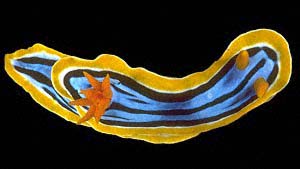
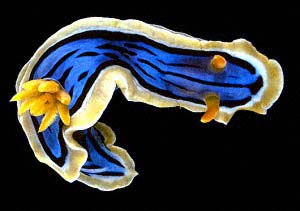
Chromodoris elisabethina
Bergh, 1877
Order: NUDIBRANCHIA
Suborder: DORIDINA
Family: Chromodorididae
DISTRIBUTION
Tropical western Pacific and perhaps into the Indian Ocean.
PHOTO
UPPER: Lizard Island, North Queensland, Australia. February 1981. 24mm long alive. PHOTO: J.Fields.
LOWER: Noumea, New Caledonia, October 1988. PHOTO: Bill Rudman
Chromodoris elisabethina is one of a group of chromodorids with a blue or bluish-white background colour and black or dark blue longitudinal lines. Often they have orange or yellow gills and rhinophores and a similarly coloured mantle border. The upper photo could be considered the "typical" colour pattern, but the orange border can be somewhat faint, (and apparently submarginal), and the median black line can be replaced by an irregular group of shorter lines. Chromodoris annae is one of the most similarly coloured species. It usually does not have a median black line and the blue areas of the mantle are not the uniform blue of C. elisabethina but have scattered darker specks, almost pits, throughout the blue areas.
See Scott Johnson's message describing its flattened egg ribbon.
Reference:
• Rudman, W.B. (1982) The Chromodorididae (Opisthobranchia: Mollusca) of the Indo-West Pacific: Chromodoris quadricolor, C. lineolata and Hypselodoris nigrolineata colour groups. Zoological Journal of the Linnean Society, 76: 183-241.
Rudman, W.B., 1998 (November 19) Chromodoris elisabethina Bergh, 1877. [In] Sea Slug Forum. Australian Museum, Sydney. Available from http://www.seaslugforum.net/find/chroelis
Related messages
Re: Chromodoris elisabethina - feeding
October 28, 2009
From: Leanne and David Atkinson
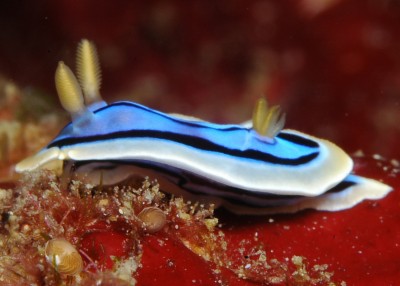
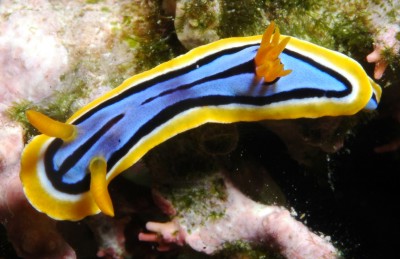
Concerning message #12031:
Dear Bill,
Here are some darker coloured Chromodoris elisabethina from Vanuata neither seems to be in the process of feeding. The first paler one is from Olly's Lolly on Mele Reef at Hideaway Island Vanuatu and the darker coloured one in the other photos is from White Rock, Moso Island Vanuatu. Hope they are of interest.
Locality: Olly's Lolly on Mele Reef at Hideaway Island; White Rock, Moso Island Vanuatu , 15metres, Efate Island Vanuatu, Pacific Ocean, 14 April 2008 & 22 April 2008, Coral Reef. Length: approximately 30mm. Photographer: Leanne and David Atkinson.
Regards,
Leanne & David Atkinson
atk@hunterlink.net.au
Atkinson, L. & D., 2009 (Oct 28) Re: Chromodoris elisabethina - feeding. [Message in] Sea Slug Forum. Australian Museum, Sydney. Available from http://www.seaslugforum.net/find/22730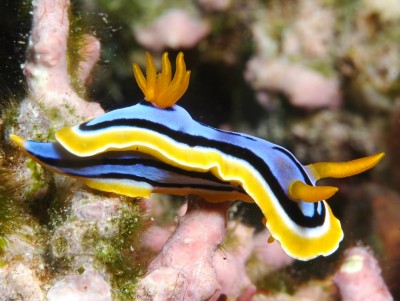
Thanks Leanne and David,
Best wishes,
Bill Rudman
Re: Chromodoris from Yap
October 28, 2009
From: David and Leanne Atkinson
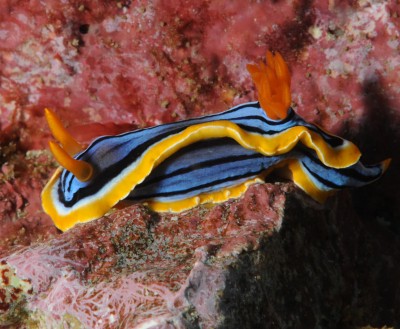
Concerning message #22718:
Dear Bill,
Following on from the discussion of Chromodoris elisabethina colouration and food here are some photos from North Solitary Island of one with strong colours near a red sponge. As it moved on the surge pushed its rhinophores so you can clearly see the anus amongst the gills. There was also a Chromodoris magnifica about a metre away. Hope this is of interest you didn't have one from the Solitary Islands and this is the second time we have seen one in this area.
Locality: Elbow Cave, North Solitary Island, Solitary Islands Marine Park, 12 metres, New South Wales, Australia, Pacific Ocean, 23 December 2008, Coral Reef. Length: approximately 30 mm. Photographer: David and Leanne Atkinson.
Regards,
Leanne & David Atkinson
atk@hunterlink.net.au
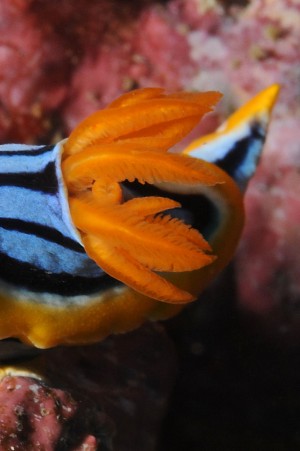
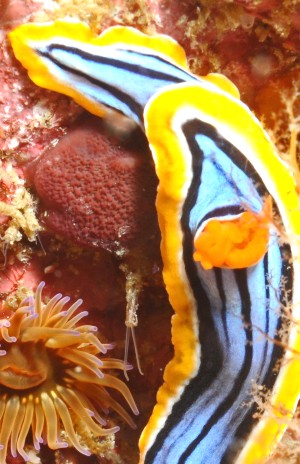
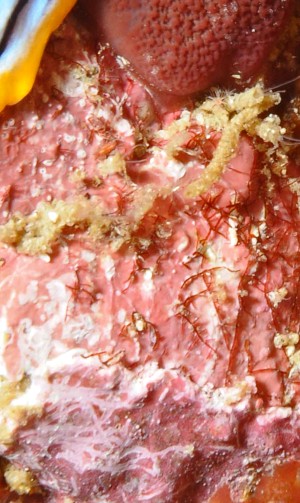
Dear David and Leanne,
Thanks for the photos. Red backgrounds can be deceptive as they are often coralline algae, but this is one of those mixed bottoms with sponge colonies as well. Very tantalising. The only sign of feeding I can see are the whitish tangled grooves on the pink coralline algae which I suspect are the feeding tracks of some herbivorous snail.
If you have a photo of your C. magnifica from Solitary Islands it would be an interesting addition because I can't recall a record from that far south.
Best wishes,
Bill Rudman
Chromodoris from Yap
October 26, 2009
From: Sylvain Le Bris
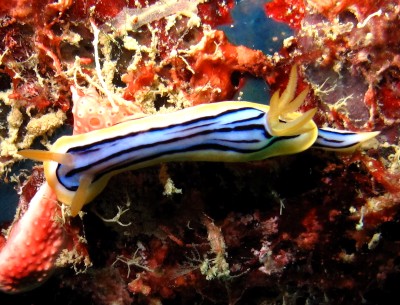
Dear Bill,
Here two pictures of the same species of Chromodoris, I guess.
They look like C. strigata, but I am not sure because of the unbroken external black line. In the 2nd picture, we can see a part of the sponge, probably eaten by the slug.
15 m, Yap, Federated States of Micronesia, Pacific Ocean, September 2009. Length: 5 cm. Photographer: Sylvain Le Bris.
Regards
Sylvain Le Bris
lebris.sylvain@gmail.com
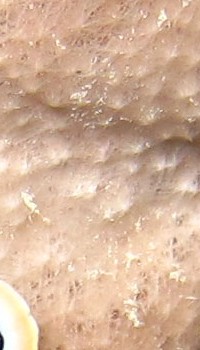


Dear Sylvain,
Thanks for these photos. They help to build up a picture of what this species feeds on. The slug is Chromodoris elisabethina and it is interesting to see that one of your animals has a much paler orange colour than the other. I have often wondered why this difference occurrs in a number of these similarly coloured species, and your photos may give us a clue ... but I must emphasise the 'may give us a clue'. C. elisabethina is one of a group of black-lined species which feed on both orange-red sponges of the genus Negombata and blackish or brownish species of the family Thorectidae. I can't be sure if the animal in the upper photo has been eating the orange-red sponge, because there are other sponges present in your photo as well, but I can definitely agree the animal in the other photo has been feeding on the pale brownish sponge which I am pretty sure is a species of thorectid. It is certainly suggestive that the nudibranch with the pale watery orange colour in the mantle is eating a sponge without any red-orange colouration. We don't have enough photos of this animal on their food to see if there is any correlation between animals with bright orange colouration and orange-red sponges but it would be worth looking out for.
In an earlier message [#20951] there is an animal on a similar sponge which I suggested may be a dysideid. On reflection, I am pretty sure it is also a thorectid.
Best wishes,
Bill Rudman
Chromodoris elisabethina from Philippines?
July 28, 2008
From: Marcel Tanke
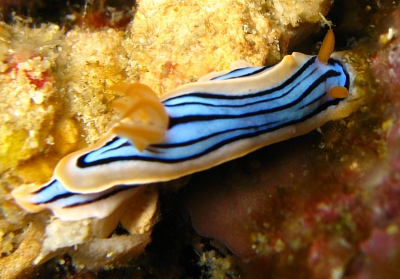
Hi Bil,
Can this be Chromodoris elisabethina? It does not have the characteristic 3 stripes, or yellow and blue color. I recently took this picture at Cebu Moalboal.
Locality: Philippines, about 10-15 meters, Cebu, Moalboal, 1 May 2008, reef. Length: 5 cm. Photographer: Marcel Tanke.
Best regards,
Marcel Tanke
marceltanke@cs.com
Tanke, M.A., 2008 (Jul 28) Chromodoris elisabethina from Philippines?. [Message in] Sea Slug Forum. Australian Museum, Sydney. Available from http://www.seaslugforum.net/find/21646Dear Marcel,
It does have the three characteristic black lines but it has a couple of extra thin ones. If you look at other photos on the Fact Sheet and attached messages you will see that there can be traces of these extra lines as spots and broken lines. The orange-yellow and blue colour can also be somewhat variable.
By the way I have changed your spelling of the name from eli[z]abethina to the correct eli[s]abethina. In these days of digital searching a mispelling like this can mean you miss a lot.
Best wishes,
Bill Rudman
Chromodoris elisabethina feeding
April 2, 2008
From: Gary Cobb
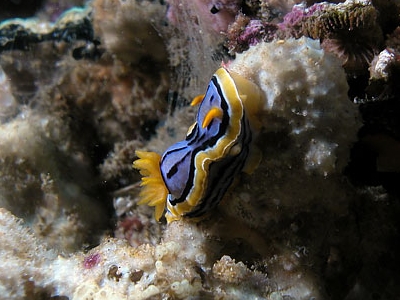
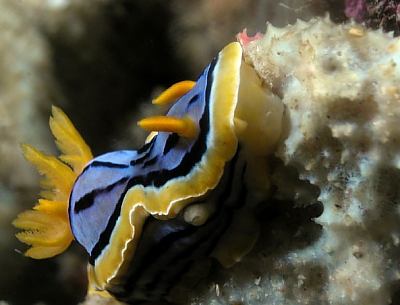
Hi Bill and everyone,
Please find attached some nice photos of a very common species here on the Sunshine Coast southern Queensland ... Chromodoris elisabethina.
Locality: Old Woman Island, Mooloolaba, Sunshine Coast, 14 m, Queensland, Australia, Pacific Ocean, 28 May 2005, Subtidal. Length: 45 mm. Photographer: Gary Cobb.
Cheers,
Gary Cobb
gary@nudibranch.com.au
Cobb, G.C., 2008 (Apr 2) Chromodoris elisabethina feeding. [Message in] Sea Slug Forum. Australian Museum, Sydney. Available from http://www.seaslugforum.net/find/20951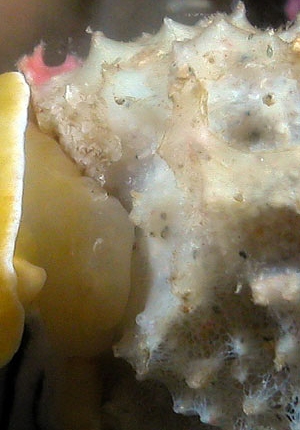
Dear Gary,
This is an interesting feeding record. So far we have only records of this species feeding in thorectid sponges but I suspect this is a species of Dysidea. I will of course have to get its identity checked, but if you have any other photos of it apparently feeding on this, or any other sponge, they would - as I am sure you realise - be very welcome.
Best wishes,
Bill Rudman
Chromodoris elisabethina from sthn Queensland
July 11, 2006
From: Ian Banks
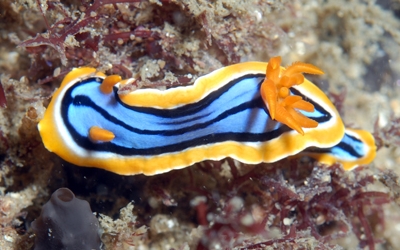
Bill,
These Chromodoris elisabethina were photographed on the North Side of Cook Island.
Locality: Cook Island, Tweed Heads, NSW, Australia, Pacific, Rocky Reef. Length: 3 cm. Upper: 09-Jul-2006, 12 metres; Lower: 26-May-2006, 6 metres. Photographer: Ian Banks.
Regards,
Ian
ianbanks@bigpond.com
Banks, I.W., 2006 (Jul 11) Chromodoris elisabethina from sthn Queensland. [Message in] Sea Slug Forum. Australian Museum, Sydney. Available from http://www.seaslugforum.net/find/17095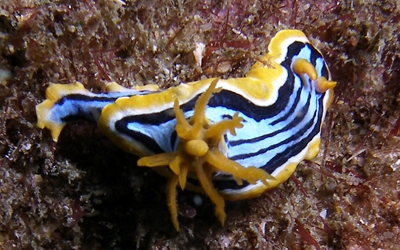
Thanks Ian,
Best wishes,
Bill Rudman
Re: Chromodoris elisabethina feeding
April 8, 2006
From: Alex Bullen
Concerning message #16254:
These creatures are amazing, i only chanced upon them yesterday when i was looking at ebay and have spent most of yesterday and today trying to find out more abour them... how long do they live for roughly?
regards
Alex
alexander.j.bullen@student.mmu.ac.uk
Bullen, A., 2006 (Apr 8) Re: Chromodoris elisabethina feeding. [Message in] Sea Slug Forum. Australian Museum, Sydney. Available from http://www.seaslugforum.net/find/16266Dear Alex,
Have a look at the Lifespan Fact Sheet and the messages attached on that page for some background information. As to how long a chromodorid would live, I'm afraid we have little concrete information although from population fluctuations during the year it seems that they, like many sea slugs, live for about a year.
If you were wondering about keeping them in aquaria my advice would be not to unless you know precisely what sponge your particular species feeds on and have an inexhaustible supply of that sponge in a healthy condition. Sponges are very difficult to transplant and keep in aquaria, and the problems greatly increase if while you are trying to keep your sponge healthy, the nuidbranch is doing what it is supposed to - biting chunks off the sponge.
Best wishes,
Bill Rudman
Chromodoris elisabethina feeding
April 7, 2006
From: Guido & Philippe Poppe


Dear Bill
Here are some photos of Chromodoris elisabethina you may find interesting from our website on Philippines marine life at
http://www.poppe-images.com/.
I am sorry that the data we keep is not as extensive as you ask for but we spend our time taking photos of all marine life rather than detailed observations of a few.
Upper photo: Hadsan, Mactan Island, Cebu, Philippines. 25 m. Night. 2005. Lower photo: Coral Point, Mactan Island, Cebu, Philippines.28 m. Night. 2005. Photos: Copyright Guido & Philippe Poppe.
Best wishes,
Guido & Philippe Poppe
philippe@conchology.be
Poppe, G. & Poppe, P., 2006 (Apr 7) Chromodoris elisabethina feeding. [Message in] Sea Slug Forum. Australian Museum, Sydney. Available from http://www.seaslugforum.net/find/16254
Dear Guido & Philippe,
Thanks for these valauable photos which show the food sponge of this species. I am pretty sure the juvemile in the lower photo is C. elisabethina. I suspect the apparent punctate pattern in the blue area, which makes it looks like C. annae, is a juvenile feature with the mantle still not completely pigmented. The sponge is a I think a species of Petrosaspongia on which the species is often found feeding. I suspect the large hole in the top of the colony has been greatly enlarged by the large spider crab which seems to be protecting it rather fiercely.
Best wishes,
Bill Rudman
Chromodoris elisabethina from sthn Queensland
January 28, 2006
From: Bruce Wilkie
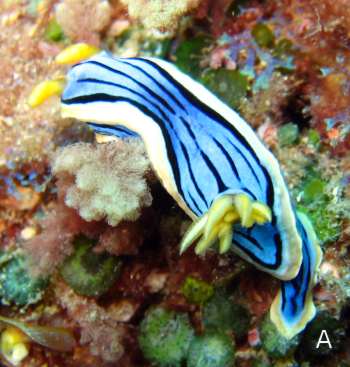
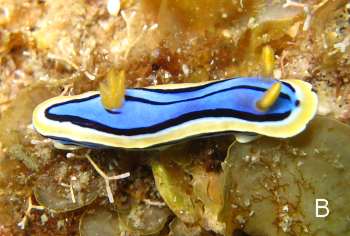
Hi Bill,
Would like to confirm if these three are Chromodoris elisabethina?
Photo A: taken at Flat Rock North Strabbroke Island on the 20 Nov 2005 in about 10 mts of water. length 45 mm
Photo B: also at Flat Rock on the 30 dec 2005 in about 14 mts. length 35mm
Photo C: Flat Rock on the 30 dec 2005 in about 15 mts length 50 mm
Locality: Flat Rock, North Stradbroke Island, Queensland Australia. Depth: 12 metres to 20 metres. rocky reef with sponges, hard & soft corals Photographer: Bruce Wilkie
Many Thanks
Bruce Wilkie.
brucedwilkie@yahoo.com.au
Wilkie, B., 2006 (Jan 28) Chromodoris elisabethina from sthn Queensland. [Message in] Sea Slug Forum. Australian Museum, Sydney. Available from http://www.seaslugforum.net/find/15658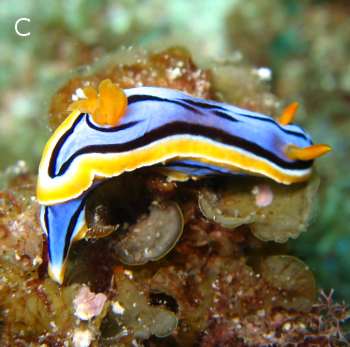
Dear Bruce,
Yes these are all C. elisabethina. Please note I have changed your spelling of the name from elizabethina. - It is spelt with an 's' not a 'z'.
Best wishes,
Bill Rudman
Chromodoris elisabethina - feeding
January 28, 2004
From: Gary Cobb
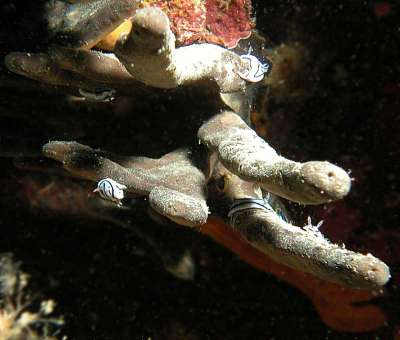
Hi Bill,
After reading about C. willani feeding I remembered a photo I took while at Hideaway Island in Vanuatu. It clearly shows C. willani and C.elisabethina feeding.
Cheers,
Gary Cobb
gary@cobb.com.au
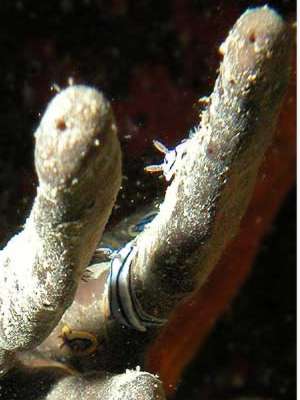
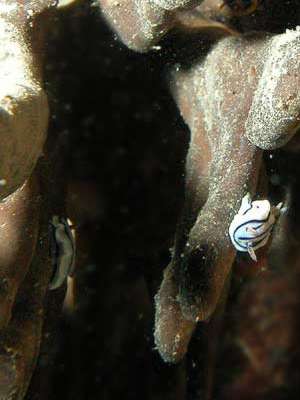
Thanks Gary,
I could be wrong, but I suspect all these slugs are Chromodoris elisabethina. If you look at other photos on this page you will see that this species ranges in colour from the spectacular blue and orange form to a quite dull colour form in which the colour looks very 'faded'.
Hopefully the sponge should be identifiable. Just as a general remark for contributors looking for sponge photos to send, the ideal set of photos for identifying sponges should include one showing the whole sponge colony, as here, and a closeup to show surface texture. Ideally we also need a sample of the sponge colony as well but that is usually not practical, unless the collector is part of an institutionally supported expedition.
Thanks again,
Bill Rudman
Chromodoris elisabethina? from Nthn Mariana Ids
December 18, 2003
From: Kenji Kobayashi
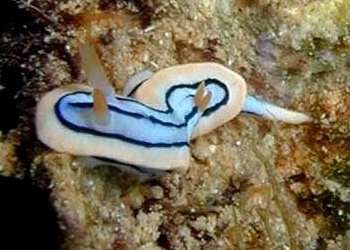
Dear Bill,
Could you identified this photo? Is it Chromodoris elisabethina?
These photos are taken in Saipan (Northern Mariana Ids).
Regards
Kenji Kobayashi
squall@gtepacifica.net
Kobayashi, K., 2003 (Dec 18) Chromodoris elisabethina? from Nthn Mariana Ids. [Message in] Sea Slug Forum. Australian Museum, Sydney. Available from http://www.seaslugforum.net/find/11660Dear Kenji,
I am pretty sure this is just a pale variety of Chromodoris elisabethina. There is already an example from Christmas Id, Indian Ocean of this pale colour form
Best wishes
Bill Rudman
Chromodoris elisabethina - spelling
May 17, 2003
From: Roberto Sozzani
Dear Bill,
What's the exact spelling for Chromodoris elisabethina? I found often 'elizabethina', also in your forum sometimes is spelled with 'z' instead of 's'.
A Google search gives lot of results with both names, so I don't know which one is the right one.
Thanks in advance.
Roberto Sozzani
roberto.sozzani@fastwebnet.it
Dear Roberto,
I discussed this is an earlier message. On checking back through the Forum I see 3 mispellings have crept through in incoming messages - which I've now corrected. The correct spelling is with an s.
Bergh first used the name Chromodoris elisabethina in 1875, but as it was just in a list with no description it is considered a nomen nudum - 'nude name'. We date the name from 1877, when it is used by Bergh with a description. Russell's very useful Index Nudibranchia (1971) lists the spelling of the name in 1875 as 'elizabethina' but in my copy of Bergh 1875 it is definitely an 's'.
Doris elizabethina Kelaart 1859, is the only possible source of confusion but the description is so poor that we can't be sure what it is - perhaps a dendrodorid.
• Bergh, L.S.R. (1875) Neue Nacktschnecken der Sudsee. III. Journal de Museum Godeffroy, 3(8): 53-100, [185-232], Pls.7-11.
• Bergh, L.S.R. (1877) Malacologische Untersuchungen. In: C.G. Semper, Reisen im Archipel der Philippinen, Wissenschaftliche Resultate, 11: 429-494, Pls.54-57.
• Kelaart, E.F. (1859) On some additional species of nudibranchiate mollusks from Ceylon. Annals & Magazine of Natural History, (Ser.3), 4: 267-270.
• Rudman, W.B. (1982) The Chromodorididae (Opisthobranchia: Mollusca) of the Indo-West Pacific: Chromodoris quadricolor, C. lineolata and Hypselodoris nigrolineata colour groups. Zoological Journal of the Linnean Society, 76: 183-241.
• Russell, H. (1971) Index Nudibranchia. Delaware Museum of Natural History: Delaware. 141pp.
Best wishes,
Bill Rudman
Chromodoris elisabethina from Lord Howe Island
January 8, 2003
From: W.B. Rudman
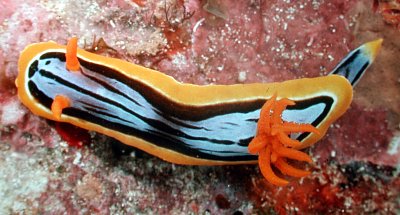
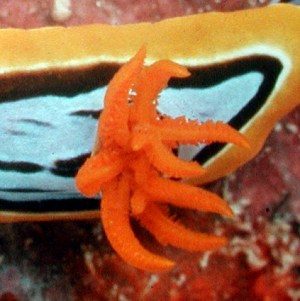
Here is a photo record from Ian Hutton of Chromodoris elisabethina from Lord Howe Island.
Location: South Reef.
Bill Rudman
Rudman, W.B., 2003 (Jan 8) Chromodoris elisabethina from Lord Howe Island. [Message in] Sea Slug Forum. Australian Museum, Sydney. Available from http://www.seaslugforum.net/find/8829Chromodoris elisabethina from Christmas Island
May 15, 2002
From: W.B. Rudman

Here is a photo of a pale specimen of Chromodoris elisabethina from John Hicks' Christmas Island, Indian Ocean collections.
PHOTO: AM C126997, 26 December 1980, ex John Burgess' aquarium, Christmas Is., Indian Ocean. Photo: John Hicks
Best wishes,
Bill Rudman
Everted penis
June 30, 2001
From: Jeanette McInnes
Dear Dr Rudman,
I am a dive instructor and nudibranch fancier living in Cairns. I love reading your internet info in the Slug Site; trying to learn more about local critters.
I never expected to have any info of my own worth emailing. I read, however, about a Chromodoris lochi travelling solo with an everted penis. I've seen penile stylets sticking out on the bodies of solo nudibranchs from time to time. The most dazzling ones are the bright blue penile stylets of Chromodoris elisabethina; quite striking against an orange mantle. I've seen this in the Cairns to Osprey Reef area & once on a 5 day holiday at Heron Island [Great Barrier Reef, Queensland].
Happy diving,
Jeanette McInnes
jlmc01@ozemail.com.au
McInnes, J., 2001 (Jun 30) Everted penis. [Message in] Sea Slug Forum. Australian Museum, Sydney. Available from http://www.seaslugforum.net/find/4668Thanks Jeanette,
Bill Rudman
What is it?
May 31, 2001
From: Rich Schreck
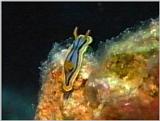
Hi-
My daughter has a budding interest in marine studies. She came across this nudibranch photo and would like to know the name of the pictured subject.
Thank you!
Rich Schreck
schreck@optonline.net
Schreck, R., 2001 (May 31) What is it?. [Message in] Sea Slug Forum. Australian Museum, Sydney. Available from http://www.seaslugforum.net/find/4466Dear Rich,
This is Chromodoris elisabethina which features in the banner at the top of each page of the Forum. If your daughter wants to know more about the species then if she looks above your message and below she will find more information and messages about this species.
If she goes to the General Topics Index (click the button at the top of the page) she will find a lot more information on nudibranchs and their relatives,
Best wishes,
Bill Rudman
Re: Chromodoris elisabethina food
March 1, 2001
From: Cody Mott
I know its been a while since you answered my previous question. I have an extreme feeling of guilt towards this nudibranch. I don't want it to die, but I also know that it wouldn't of had much more of a chance in any other tank. Is there any way out of this and a chance I can save its live. I know it is only one thing, but I have had enough things die in my tank that I couldn't prevent and I don't need one which I could have prevented.
PLEASE HELP
Cody
kwool@hotmail.com
Mott, C., 2001 (Mar 1) Re: Chromodoris elisabethina food. [Message in] Sea Slug Forum. Australian Museum, Sydney. Available from http://www.seaslugforum.net/find/3832Dear Cody,
I'm afraid there is nothing more to say. The only possibility is that if you live near the sea and there is a species of sponge living there that is related to its normal food sponge (Dysidea sp perhaps?) then there there is an extremely slight chance that your Chromodoris would eat it. But I do not know what C. elisabethina eats naturally, and am not an expert on your local sponge fauna, so I can't give you any sensible advice.
Best wishes,
Bill Rudman
Chromodoris elisabethina food
January 6, 2001
From: Cody Mott
Dr Bill Rudman had recently answered a question I had on the ID of a nudibranch I now know to be called Chromodoris elisabethina. He mentioned that they aren't suited well for the home aquaria since they eat sponges. Is this definitely true or could I have a related species that eats something else. If not, what can I feed him/her? I'm going to talk to the person which I bought it off of, but I figured it would be good to get an answer from you also.
Thank you very much,
Cody Mott
PS: Mr. Rudman please understand my second guessing of your answer, because I trust the person which I bought the nudibranch off of. I in no way meant to insult your apparent knowledge of this subject which I know reaches far more deeper than that of the person I bought it off in this subject.
Cody Mott
kwool@hotmail.com
Mott,C., 2001 (Jan 6) Chromodoris elisabethina food. [Message in] Sea Slug Forum. Australian Museum, Sydney. Available from http://www.seaslugforum.net/find/3481Dear Cody,
No I'm not insulted. It's very sensible of you to check what you read on the web as there is an awful lot of rubbish published without any quality control. All I can say is that I am a professional biologist who has spent all his career studying these animals. The Forum is published by the Australian Museum and contrary views are welcomed and published. With about 450 people visiting the Forum each day, if anyone disagrees with what I say then I usually get a message to that effect within a day or so.
The only way to really check is to either consult another expert or have a look at some books or scientific journals. If you go to the Species List and look at some of the pages on chromodorids you will find references to various scientific publications. Also have a look at the Book Review section for some books which may be of value to you.
Basically all nudibranchs are carnivores, and most are very specialised feeders. All chromodorids (including Chromodoris, Hypselodoris, Glossodoris) are sponge feeders, each species having its own preferred sponges. As I said in answer to your last message, have a look at the discusssion on the Hypselodoris bullocki pages where this very problem of what to feed them has been going on for a couple of years.
Basically your aquarium shop owner just doesn't know what they eat or has been misled by his supplier. Either way, there is no easy answer to your problem. As far as I know there is no artificial substitute.
Best wishes,
Bill Rudman
What is its name?
January 1, 2001
From: Cody Mott
I have recently purchased a nudibranch for my 29 gallon saltwater aquarium. As with all the animals I purchase I strive to find out all that I can about them. The nutibranch that I got looks to be the same exact one that is pictured at the top of all the pages of this Forum. Could somebody please help me find out what more about it. I'm sure since it is pictured on all the pages and I paid only $22 for it that the species is fairly common.
Thanks for all the help.
Cody Mott
kwool@hotmail.com
Mott, C., 2001 (Jan 1) What is its name?. [Message in] Sea Slug Forum. Australian Museum, Sydney. Available from http://www.seaslugforum.net/find/3453Dear Cody,
The animal at the top of the page is Chromodoris elisabethina. If you go to that page, by clicking on the underlined name, you will find some information about it.
All chromodorids feed on sponges, and in particular those that are without siliceous spicules. Unfortunately I can't tell you which species C. elisabethina prefers although it is most probably a species of Dysidea, Darwinella or Aplysilla. As you will see from the on-going discussion on the Hypselodoris bullocki pages, keeping tropical nudibranchs in aquaria is usually a case of slowly starving them to death. If the shop owner tells you they eat algae he either doesn't know what he is talking about or is lying. If tropical fish were very specialised feeders and impossible to feed in captivity there would be a public outcry against their sale to aquarium hobbyists. I think it is the responsibility of the aquarium trade to find a substitute food for these animals before they start profitting from their sale and ultimate starvation.
Bill Rudman.
Chromodoris elisabethina from Coral Sea
October 20, 2000
From: Des Paroz
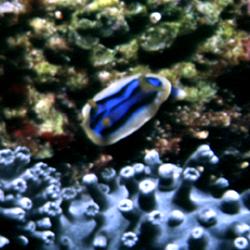
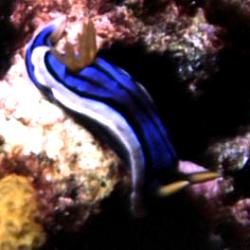
Hi Bill
Two more photos from my batch at the Coral Sea (the same roll that others were on that was underexposed due to faulty TTL).
I presume that these are both C. elisabethina.
Best regards
Des
des@paroz.com
Paroz, D., 2000 (Oct 20) Chromodoris elisabethina from Coral Sea. [Message in] Sea Slug Forum. Australian Museum, Sydney. Available from http://www.seaslugforum.net/find/3187Dear Des,
Yes these are C. elisabethina.
Best wishes,
Bill Rudman.
Pretty Chromodoris elisabethina
August 14, 2000
From: Stuart Hutchison
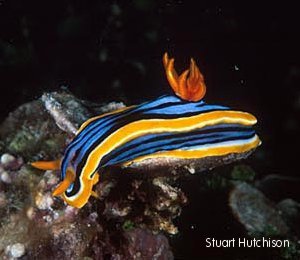
Dear Bill,
This guy/girl was found on Flinders Reef (Great Barrier Reef - Australia) in March 2000 at about 6m deep at the top of a coral bommie. It was a cooperative specimen that seemed happy under the limelight.
Stuart
hutchco@tpg.com.au
Hutchison, S., 2000 (Aug 14) Pretty Chromodoris elisabethina. [Message in] Sea Slug Forum. Australian Museum, Sydney. Available from http://www.seaslugforum.net/find/2864Dear Stuart,
Seems like you had an interestng visit to the Great Barrier Reef. In any chromodorid beauty contest Chromodoris elisabethina would certainly be amongst the medals.
At the risk of sounding pedantic, I have corrected your spelling of the name 'elizabethina' to 'elisabethina'. Bergh used the 'z' version invalidly in 1875, but in the first valid description (1877) he spelt it with an 's'. To any English speaker, where Elizabeth is usually spelt with a 'z' it is a trap.
Best wishes,
Bill Rudman.
Chromodoris elisabethina from Papua New Guinea
May 7, 1999
From: Clay Carlson
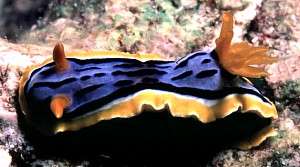
Bill,
Gustav Paulay took this photo in PNG. Is it one you know? We have seen 'normal' Chromodoris elisabethina in PNG and this one just didn't seem to fit.
Clay
Merizo, Guam.
clay.carlson@kuentos.guam.ne
Carlson, C. & Hoff, P.J., 1999 (May 7) Chromodoris elisabethina from Papua New Guinea. [Message in] Sea Slug Forum. Australian Museum, Sydney. Available from http://www.seaslugforum.net/find/841Dear Clay,
I'm pretty sure it's a form of Chromodoris elisabethina. Have a look at the second photo at the Top of The Page.
Bill Rudman.
Rudman, W.B., 1999 (May 7). Comment on Chromodoris elisabethina from Papua New Guinea by Clay Carlson . [Message in] Sea Slug Forum. Australian Museum, Sydney. Available from http://www.seaslugforum.net/find/841Chr. elisabethina juvenile? from SE Sulawesi
November 30, 1998
From: Lindsay Warren
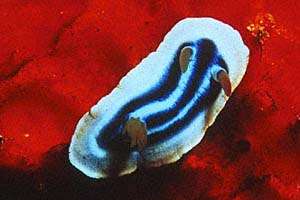
Dear Bill
Here is another chromodorid from Operation Wallacea on Pulau Hoga in the Tukang Besi Islands off SE Sulawesi, Indonesia. Length: 25 mm
Thanks,
Lindsay Warren
100014.2112@compuserve.com
Warren, L., 1998 (Nov 30) Chr. elisabethina juvenile? from SE Sulawesi. [Message in] Sea Slug Forum. Australian Museum, Sydney. Available from http://www.seaslugforum.net/find/343Lindsay,
I think this is a juvenile Chromodoris elisabethina in which the orange border is just becoming evident. It would be useful to have some indication of size. .. Bill Rudman.
